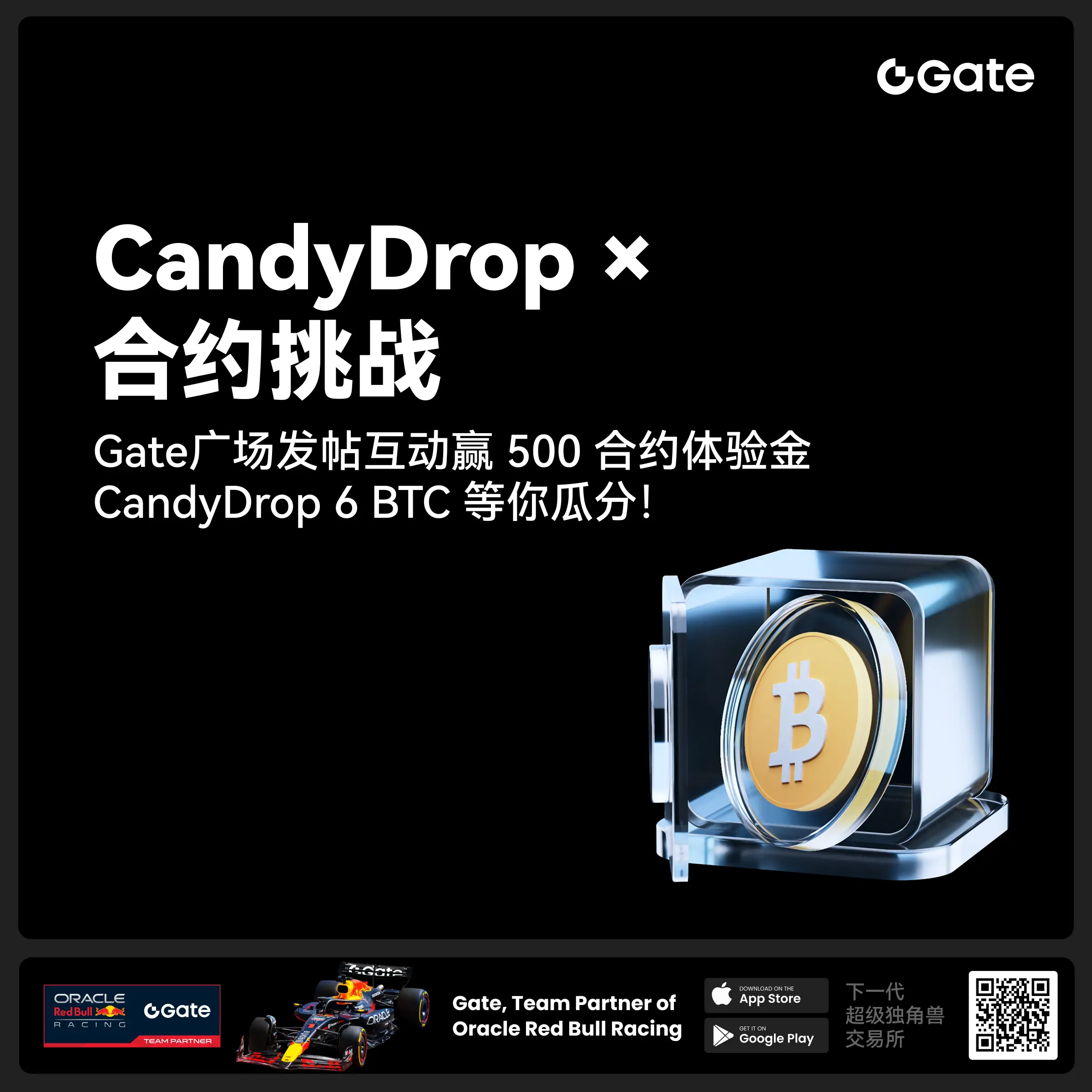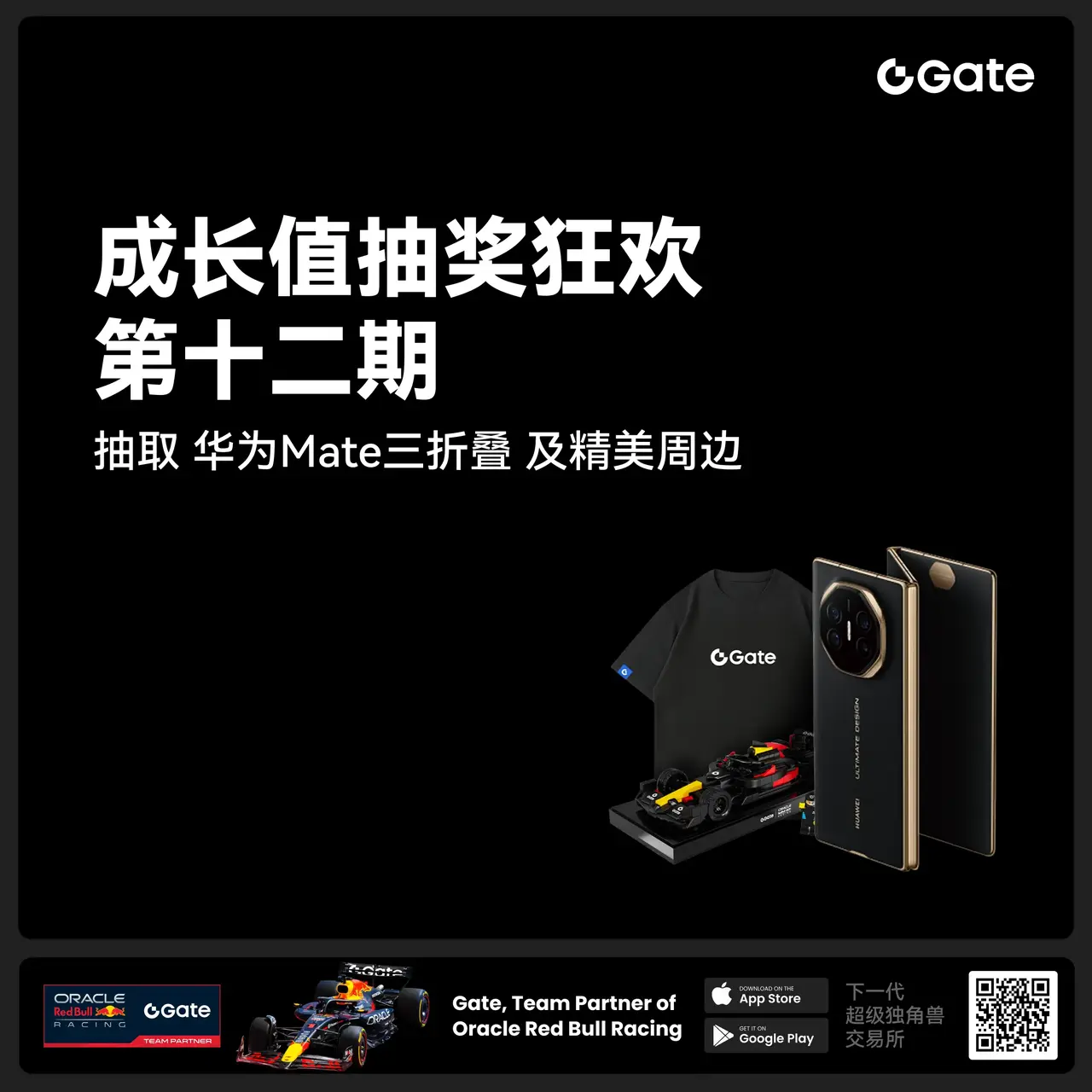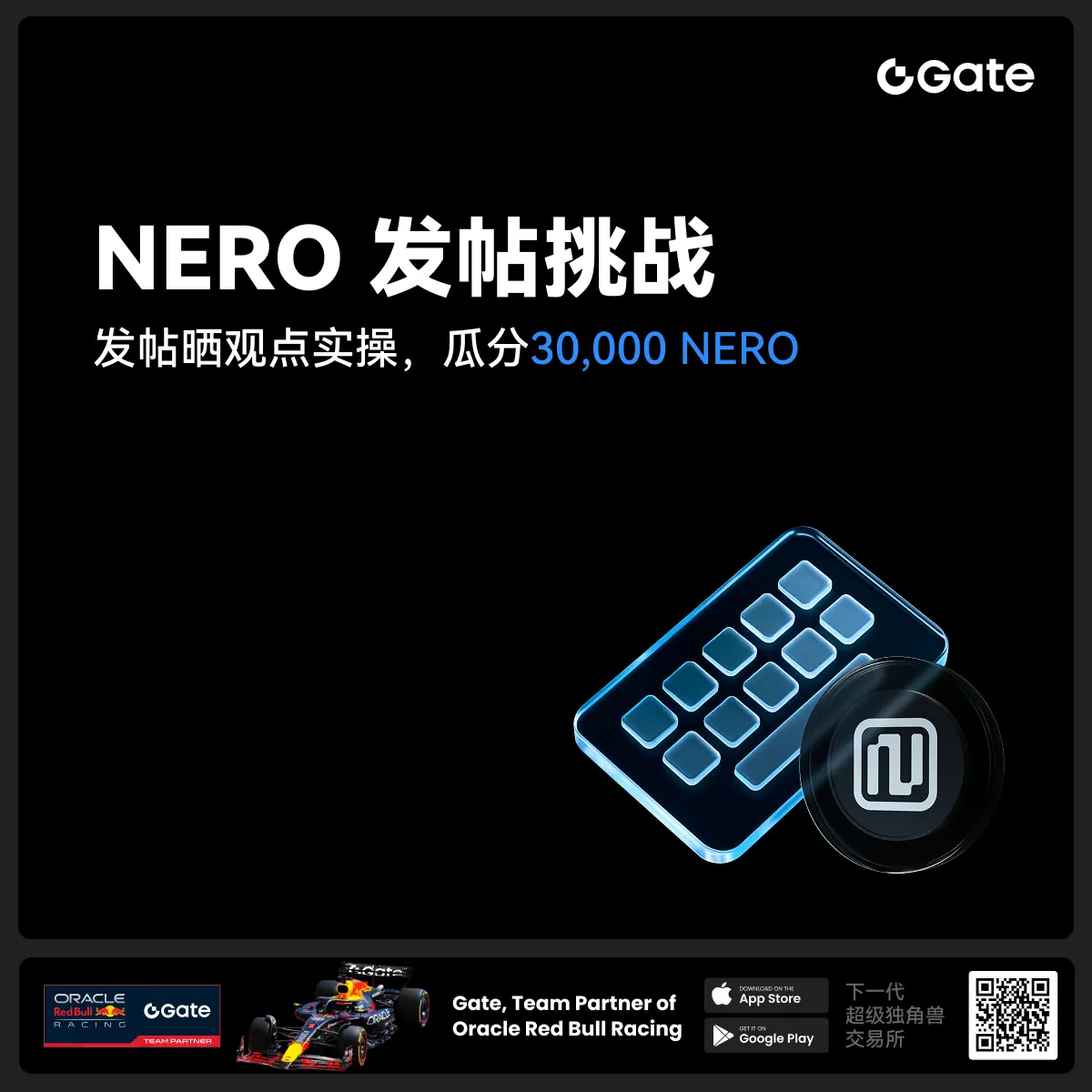- 話題1/3
88215 熱度
61477 熱度
76831 熱度
10218 熱度
24900 熱度
- 置頂
- 🎉 #CandyDrop合约挑战# 正式開啓!參與即可瓜分 6 BTC 豪華獎池!
📢 在 Gate 廣場帶話題發布你的合約體驗
🎁 優質貼文用戶瓜分$500 合約體驗金券,20位名額等你上榜!
📅 活動時間:2025 年 8 月 1 日 15:00 - 8 月 15 日 19:00 (UTC+8)
👉 活動連結:https://www.gate.com/candy-drop/detail/BTC-98
敢合約,敢盈利
- 🎉 攢成長值,抽華爲Mate三折疊!廣場第 1️⃣ 2️⃣ 期夏季成長值抽獎大狂歡開啓!
總獎池超 $10,000+,華爲Mate三折疊手機、F1紅牛賽車模型、Gate限量週邊、熱門代幣等你來抽!
立即抽獎 👉 https://www.gate.com/activities/pointprize?now_period=12
如何快速賺成長值?
1️⃣ 進入【廣場】,點擊頭像旁標識進入【社區中心】
2️⃣ 完成發帖、評論、點讚、發言等日常任務,成長值拿不停
100%有獎,抽到賺到,大獎等你抱走,趕緊試試手氣!
截止於 8月9日 24:00 (UTC+8)
詳情: https://www.gate.com/announcements/article/46384
#成长值抽奖12期开启#
- 📢 Gate廣場 #NERO发帖挑战# 秀觀點贏大獎活動火熱開啓!
Gate NERO生態周來襲!發帖秀出NERO項目洞察和活動實用攻略,瓜分30,000NERO!
💰️ 15位優質發帖用戶 * 2,000枚NERO每人
如何參與:
1️⃣ 調研NERO項目
對NERO的基本面、社區治理、發展目標、代幣經濟模型等方面進行研究,分享你對項目的深度研究。
2️⃣ 參與並分享真實體驗
參與NERO生態周相關活動,並曬出你的參與截圖、收益圖或實用教程。可以是收益展示、簡明易懂的新手攻略、小竅門,也可以是行情點位分析,內容詳實優先。
3️⃣ 鼓勵帶新互動
如果你的帖子吸引到他人參與活動,或者有好友評論“已參與/已交易”,將大幅提升你的獲獎概率!
NERO熱門活動(帖文需附以下活動連結):
NERO Chain (NERO) 生態周:Gate 已上線 NERO 現貨交易,爲回饋平台用戶,HODLer Airdrop、Launchpool、CandyDrop、餘幣寶已上線 NERO,邀您體驗。參與攻略見公告:https://www.gate.com/announcements/article/46284
高質量帖子Tips:
教程越詳細、圖片越直觀、互動量越高,獲獎幾率越大!
市場見解獨到、真實參與經歷、有帶新互動者,評選將優先考慮。
帖子需原創,字數不少於250字,且需獲得至少3條有效互動
- 🎉 親愛的廣場小夥伴們,福利不停,精彩不斷!目前廣場上這些熱門發帖贏獎活動火熱進行中,發帖越多,獎勵越多,快來GET你的專屬好禮吧!🚀
1️⃣ #GateLaunchpad上线IKA# |IKA認購體驗
在Gate廣場帶話題曬出你的IKA Launchpad認購體驗,4位幸運分享者講瓜分$200分享獎池!
詳情 👉️ https://www.gate.com/post/status/12566958
2️⃣ #ETH冲击4800# |行情分析預測
大膽發帖預測ETH走勢,展示你的市場洞察力!10位幸運用戶將平分0.1 ETH 獎勵!
詳情 👉️ https://www.gate.com/post/status/12322403
3️⃣ #创作者活动第二期# |ZKWASM話題
在廣場或推特發布與 ZKWASM 或其交易活動相關的原創內容,瓜分4,000枚ZKWASM!
詳情 👉️ https://www.gate.com/post/status/12525794
4️⃣ #Gate广场征文活动第二期# |ERA話題
談談你對ERA的觀點/體驗,參與並推廣活動,700 ERA大獎等你贏!
詳情 👉️ https://www.gate.com/post/status/12361653
5️⃣ #MBG任务挑战# |MBG話題
分享你對MBG的洞察,積極參與和推廣MBG活動,20位小
Solana DePIN報告:從"挖礦"到"地圖",普通人如何躺着賺錢?
原文:Dune、Slice Analytics
編譯:Yuliya,PANews
在區塊鏈行業衆多創新中,去中心化物理基礎設施網路(DePIN)正迅速崛起,成爲現實世界資產上鏈的橋梁。無論是共享GPU、電信網路,還是街頭地圖採集,DePIN正通過加密激勵機制,重塑基礎設施的構建與運營方式。Solana正逐漸成爲這一趨勢的核心平台,其高性能網路爲DePIN項目提供了理想的擴展土壤。
本文基於Dune與Slice Analytics聯合發布的最新研究報告,圍繞Solana上多個核心DePIN項目的發展現狀、市場表現與鏈上數據展開深入分析。報告數據截至2025年4月22日,爲我們提供了一幅關於這個新興生態系統的清晰圖景,並揭示了其背後真實可驗證的增長軌跡。
DePIN概念與Solana優勢
什麼是DePIN?
去中心化物理基礎設施網路(DePIN)是一種創新模式,它利用加密貨幣激勵機制來啓動和運營現實世界的基礎設施。這些項目通常針對需求強勁但供應效率低下的市場,盤活閒置資源(如空閒GPU、無線帶寬等)。與傳統由大型企業主導的基礎設施模式不同,DePIN將所有權分配給個人,從而提高效率、增強韌性並擴大可訪問性。
爲何選擇Solana?
Solana憑藉其高吞吐量、低交易費用和可組合的基礎設施,成爲DePIN應用透明擴展的理想平台。其蓬勃發展的生態系統和強大的開發者社區正使其成爲這一新興領域的中心。正如 Solana基金會DePIN負責人Amira Valliani所言:
"DePIN 即將達到逃逸速度。這種創新的商業模式已經證明了其能夠以社區驅動的方式更快、更便宜地擴展實體基礎設施網路 - 而這一切都發生在Solana上。全球最大的DePIN項目選擇在Solana上構建,是因爲其高性能和活躍的資本市場,並因其繁榮的社區生態系統而留下。"
DePIN市場概覽
截至2025年4月,全球DePIN項目的總鏈上市值(不包括獨立項目L1/鏈)已達71億美元,其中Solana上的DePIN項目總市值爲32.5億美元,領先於EVM(28.4億美元)和Cosmos(6.525億美元)、Cardano(1.952億美元)和Sora(1.601億美元)等其他區塊鏈平台。
按每個項目的平均市值計算,Solana以1.913億美元再次領先,Cardano(9760萬美元)、Cosmos(9320萬美元)、Sora(8010萬美元)和EVM(4060萬美元)緊隨其後。
項目類別分布
DePIN項目主要分爲五大類別:
計算(Compute):佔市場份額71.2%,提供去中心化的處理能力、GPU和計算基礎設施,如Render、io.net、Nosana、,LooPIN Network、Hivello
無線(Wireless):佔市場份額22.2%,提供社區驅動的無線和移動接入網路,如 Helium、ROAM Token、 Helium Mobile
傳感器(Sensor):通過分布式傳感設備收集現實世界數據,如Hivemapper、Geodnet、WeatherXM,、NATIX Network
服務器(Server):提供分布式雲和存儲服務器,用於托管或訪問數據,如Shadow Token、ScPrime
AI:支持AI數據生成、標注或機器人技術的去中心化網路,如UpRock、Homebrew Robotics Club
計算和無線類別合計佔據了93.4%的市場份額,也是平均市值最高的類別。計算網路如Render和io.net爲AI工作負載提供高市值實用型代幣,而無線項目如Helium和ROAM代表了最成熟和被廣泛採用的基礎設施層。
節點增長與網路參與
截至2025年4月22日,Solana上DePIN項目的總註冊鏈上節點數量達到238,165個。DePIN節點是物理或數字基礎設施單元,如GPU、物聯網熱點或行車記錄儀,執行計算、數據收集或無線傳輸等關鍵網路功能。節點數量的增長反映了網路的規模、去中心化程度和實用性,更多節點通常意味着更強的覆蓋範圍、更高的參與度和可靠性。
在節點增長方面,Solana DePIN項目呈現明顯變化。Hivemapper最初領先,但Helium在推出Helium Mobile後迅速超越,現在佔據新節點份額的60%以上。雖然Render貢獻的新節點較少,但它在每節點收入方面領先。Nosana在2025年初獲得牽引力,而Uprock在2024年末快速增長後趨於平緩。
鏈上網路收入
隨着加密貨幣行業的成熟,鏈上收入已成爲評估項目可行性、產品市場契合度和可持續商業模式的關鍵指標。截至2025年4月22日,Solana上DePIN項目的總鏈上收入達到598萬美元。
DePIN項目在Solana上的收入穩步增長,從2023年4月的每週約4,000美元增長到2025年初的每週超過10萬美元,在4月中旬達到峯值13萬美元。Helium是每週最高收入者,達6萬美元(60%份額),而Render在總收入上領先(265萬美元,相比Helium的230萬美元)。Render還保持了2024年末創下的單周收入峯值30萬美元的記錄。這些趨勢突顯了不斷上升的採用率,每個項目在DePIN增長週期的不同時點獲得牽引力。
主要項目分析
Helium是一個去中心化無線網路,使個人能夠部署熱點並爲物聯網和移動設備提供低成本、安全的連接。用戶通過擴展覆蓋範圍和路由數據獲得HNT代幣獎勵。
重要裏程碑:
2013年:Helium成立
2019年:Helium熱點推出,用戶開始因覆蓋範圍而獲得HNT
2023年:遷移至Solana以提高可擴展性和速度
2024年:公開發布Helium Mobile,一種去中心化5G服務
2025年:推出Zero Plan,美國首個免費5G手機套餐
2025年:SEC撤銷對Nova Labs的訴訟,確認Helium的代幣模型不違反證券法
2025年:Helium與AT&T合作提供全國Wi-Fi覆蓋
關鍵數據:
總訂閱用戶:176,301
總節點數:69,449
總鏈上收入:229萬美元
Helium的訂閱用戶增長受到明確的產品驅動拐點影響。2024年1月,Helium Mobile正式發布後的一周內新增訂閱用戶達到10,300人,促進了更多熱點的部署和網路擴展。隨後,2025年2月推出的Zero Plan(美國首個免費5G手機套餐)引發了第二波增長,迅速填滿了等待名單。4月向所有人開放免費套餐後,用戶數再次達到10,000人的峯值。
截至報告期,Helium的總訂閱用戶數已達176,301名,總節點數爲69,449個。節點構成呈現出不斷變化的趨勢,其中移動數據專用類別增長尤爲強勁。報告指出,兩個主要事件推動了節點部署的高峯。首先是2024年10月與Ameriband的合作,在美國的零售和商業站點新增了超過100,000個僅數據熱點;其次是2025年4月取消Zero Plan等待名單後,用戶增長再次加速。
Helium通過其獨特的燃燒-鑄造模型產生鏈上收入,用戶可以將HNT轉換爲不可轉讓的數據信用(DCs),以便訪問其物聯網和移動網路上的服務。具體而言,移動數據按每千兆字節0.50美元(即50,000 DCs)計費,而物聯網使用則按每24字節消息增量收費。公司收入穩步增長,在2024年12月創下每週66,000美元的記錄,並在2025年4月再次達到每週63,000美元的持續峯值。
Hivemapper是一個去中心化、社區驅動的地圖網路,用戶通過行車記錄儀收集街道級圖像獲得HONEY代幣獎勵。通過將日常駕駛轉變爲數據源,Hivemapper爲運輸、物流和自動駕駛等領域提供更新鮮、更動態的地圖。
重要裏程碑:
2022年:推出Hivemapper網路和HONEY代幣
2023年:網路映射的獨特道路公裏數超過100萬
2024年:推出Bee行車記錄儀,用於高質量圖像捕捉
2024年:發布Beekeeper,一個無SaaS鎖定的車隊管理工具
2025年:Bee Maps開始爲TomTom、Mapbox和Trimble等主要客戶提供服務
關鍵數據:
總節點數:77,483
每週獎勵:超過6萬美元HONEY
截至2025年4月,網路已擁有77,483個節點,其中大多數活躍於AI訓練和懸賞活動,然而不到10%的節點因地圖覆蓋而獲得獎勵。盡管Hivemapper的每週獎勵從2023年12月的峯值140萬美元有所下降,網路仍每週分發超過6萬美元的HONEY代幣。值得注意的是,雖然僅有不到10%的節點積極貢獻地圖覆蓋,但這些節點始終獲得總獎勵的約80%。
Hivemapper通過出售Map Credits(每個價值0.005美元)賺取收入,這些信用通過燃燒HONEY代幣購買,用於訪問地圖數據。收入趨勢顯示,在2023年底達到每週3萬美元的峯值,並在2024年4月至5月期間超過每週5萬美元。
Render網路是一個高性能分布式GPU渲染網路,利用行業領先的OTOY Inc.軟件促進GPU提供者和請求者之間的計算市場。GPU所有者可以通過向尋求渲染資源的創作者提供計算能力來將閒置GPU貨幣化。它爲3D圖形、動態設計和AI工作負載提供可擴展、經濟的渲染服務。
重要裏程碑:
2021年:Render去中心化渲染網路啓動
2023年:遷移至Solana並將代幣升級爲RENDER
2024年:通過RNP-017集成OctaneRender for Blender
關鍵數據:
活躍鏈上節點:3,784
已燃燒的RENDER代幣:超過1.21億
分發給節點運營商的代幣:超過240萬
Render網路允許任何擁有閒置GPU容量的人成爲節點運營商,爲去中心化渲染和AI基礎設施貢獻計算能力。節點運營商將其GPU能力出租給需要可擴展、按需計算的藝術家、工作室和AI開發者,作爲回報,他們獲得RENDER代幣。
截至2025年4月,Render Network擁有3,784個活躍的鏈上節點,爲不斷增長的創意和AI應用生態系統提供去中心化計算能力。迄今爲止,用戶訪問GPU能力已燃燒超過1.21億RENDER代幣,同時鑄造了超過240萬代幣獎勵節點運營商,顯示出健康的需求和生態系統的活躍參與。此前消息顯示,收入在2024年11月到12月達到每週近30萬美元的峯值,這得益於關鍵升級(RNP-016到018)、擴展的藝術家激勵和帶有免費GPU積分和獎品的Advent Calendar活動。2025年4月中旬出現另一個顯著峯值,每週收入達到7萬美元,表明創作者需求和網路採用率正在回升。
Nosana是一個去中心化計算網路,用戶可以通過全球GPU主機網格運行AI推理任務。參與者將閒置GPU註冊爲節點,並通過完成網路特定作業市場中的任務賺取$NOS代幣。Nosana的解決方案提供了一個可擴展、抗審查的替代方案,利用全球未充分利用的GPU資源,爲AI計算提供更具成本效益的選擇。
重要裏程碑:
2024年:啓動全球測試網格
2024年:發布Node V2,大幅提升性能
2025年:GPU市場主網上線
關鍵數據:
全球節點數:超過4,200
每日活躍節點:從2024年平均300個增加到2025年超過600個
2025年1月,Nosana正式向公衆推出其去中心化GPU市場。這次發布在經過一年的封閉測試後,引發了節點活動的顯著增長:日活躍節點從2024年平均300個增加到超過600個,2025年3月峯值超過800個。這一增長表明GPU主機和AI開發者的採用率不斷提高。
全球已有超過4200個節點加入,Nosana展示了可擴展性能和持續活動,成爲傳統計算提供商的強大去中心化替代方案。其鏈上活動由節點運營商與工作市場的互動驅動,反映出其去中心化GPU網路的實際使用情況。網路在2024年5月達到每週超過20萬次操作的歷史最高點,並穩定在約8萬次操作,顯示出對計算任務的健康、持續需求。
大部分活動來自三個關鍵指令類型:創建新工作崗位、節點排隊執行任務以及完成任務並支付報酬,這三項指令代表了網路上的核心工作生命週期,保持了相對穩定的使用模式。較少出現的指令如停止、退出和清理,每週約1000次,顯示出較低的早期任務終止或清理率,進一步表明系統穩定性和激勵機制的良好對齊。
UpRock是一個由移動優先DePIN模型驅動的去中心化數據智能網路。用戶可以通過UpRock應用共享未使用的互聯網帶寬和計算能力,將日常設備轉變爲被動數據貢獻者,從而賺取$UPT代幣。這些資源爲AI模型提供實時、地理多樣化和抗審查的數據支持。
UpRock通過SaaS訂閱和按使用付費的API實現貨幣化,部分收入用於鏈上$UPT代幣回購,爲貢獻者獎勵提供資金並強化生態系統。2025年2月鏈上網路收入達到每週超過3,000美元的峯值後,收入一直穩定在每週1,500美元。
結論與關鍵見解
Solana在DePIN領域的領導地位:如果協議選擇不推出自己的獨立L1/區塊鏈,Solana已成爲DePIN的領先鏈,DePIN項目總市值達32.5億美元,每個項目平均市值1.913億美元。
鏈上活動證明DePIN的實際價值:DePIN不僅僅是一種敘事。Helium、Render和Hivemapper等項目共產生了近600萬美元的鏈上網路收入,這是真實產品市場契合度的強烈信號。
計算和無線類別主導市場:計算(71.2%)和無線(22.2%)類別在Solana DePIN領域市場份額領先(合計93.4%)。
節點增長和服務採用加速:Helium超過17.6萬移動用戶和6.9萬節點,而Hivemapper和Render繼續擴大其貢獻者基礎。Nosana在主網啓動後活躍節點數量翻倍。
透明度挑戰仍存:盡管有實際應用,DePIN仍然是最難追蹤鏈上活動的加密領域之一,因爲它依賴於鏈下硬件和第三方集成。雖然已取得進展,但完全透明和一致的鏈上測量仍在進行中。